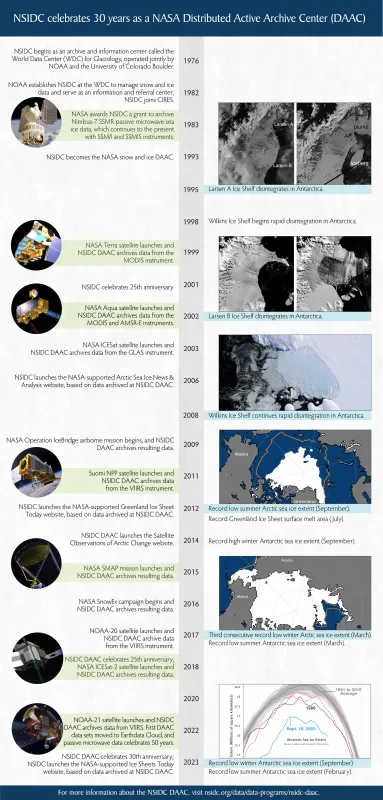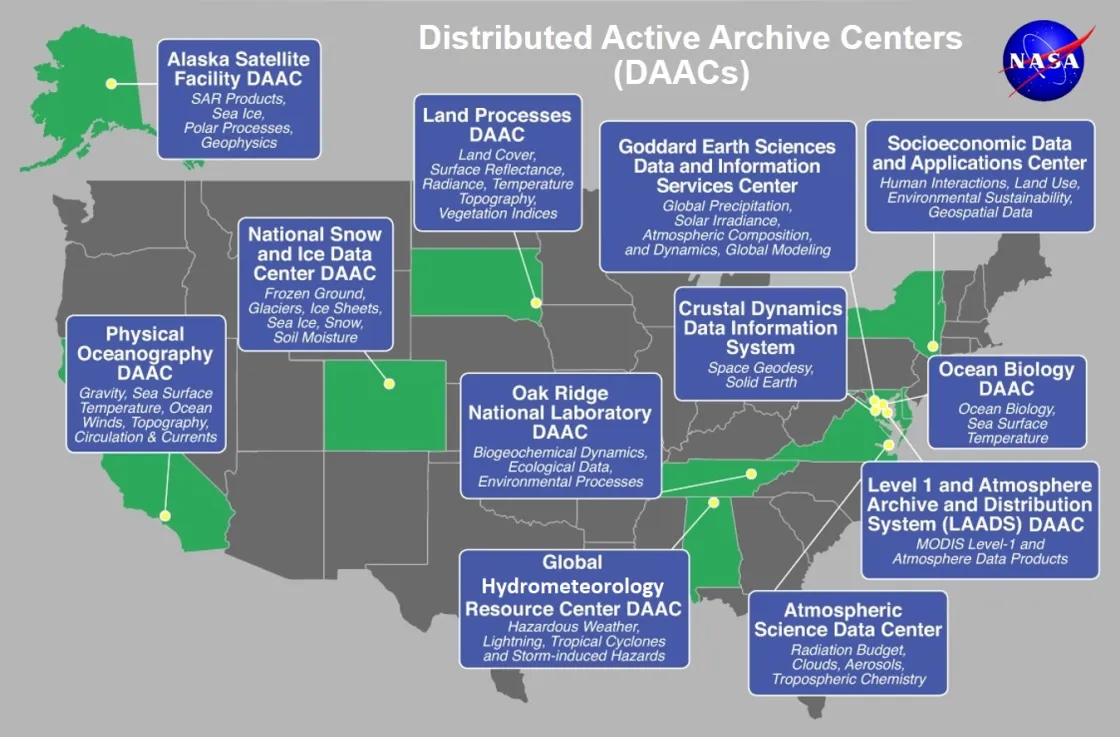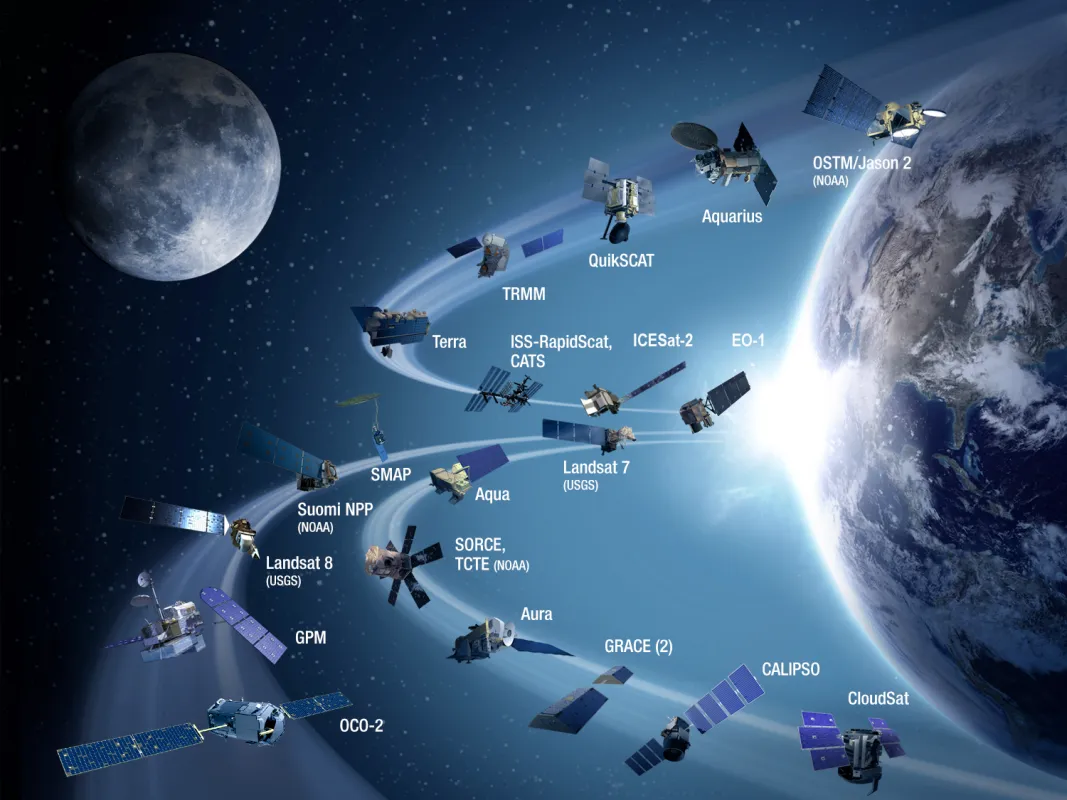By Agnieszka Gautier
As rings circle Saturn, a brick moon would revolve in Earth’s orbit in perpetuity. So envisioned Edward Everett Hale in “The Brick Moon,” an 1869 novella describing the construction and launch of the first theoretical satellite—a moon constructed out of bricks, able to endure the heat of Earth’s atmosphere. Thus, a seed was planted into human consciousness to observe our planet. Less than a century later in 1957, the Soviet Union launched Sputnik, the first man-made satellite to support scientific research, marking the beginning of the Space Age. In response, a year later, the United States sent Explorer 1 into space.
Then, NASA opened for business on October 1, 1958, and eventually established the Earth Observing System (EOS): a network of satellites to monitor key components of Earth’s climate system and their interactions through long-term global observations. Initially, one center was conceived to store all data. But as data complexity grew, NASA turned to a robust enterprise that would offer seamless access to multidisciplinary data from Earth’s atmosphere, biosphere, land surfaces, poles, solid Earth, and ocean. By the 1990s, nine Distributed Active Archive Centers (DAACs) were established to ingest, host, archive, and freely distribute data from these burgeoning satellites and missions. Each center aligned with an instrument like passive microwave or was distinguished by an Earth Science discipline.
In 1993, NASA contracted the National Snow and Ice Data Center (NSIDC) at the University of Colorado Boulder to steward snow- and ice-related data, forming the NSIDC DAAC. The year 2023 marks 30 years that NSIDC has operated the NASA snow and ice DAAC. Initially, it only supported a couple of satellite missions. Today, the NSIDC DAAC manages data for 21 missions or projects. Over the 30 years, the NSIDC DAAC has evolved to archive and distribute more and bigger data while adapting to changing user needs with groundbreaking applications and tools, educational resources, and other services.
A constellation of data centers
Today, the NSIDC DAAC is one of twelve DAACs. From the beginning, the NSIDC DAAC has been NASA’s foremost expert on snow and ice data. NASA originally approached NSIDC because it was already renowned within the research and data community for its work on Earth’s cryosphere, or frozen land and water features. In addition, NSIDC already managed passive microwave data for the National Oceanic and Atmospheric Administration (NOAA) and had been a part of the World Data Center (WDC) for Glaciology since 1957.
Since then, NSIDC has continued to build upon its reputation in cryospheric research and data management. NSIDC DAAC leverages this expertise to go beyond archiving and distributing NASA mission data to develop documentation, tools, and services that improve how users locate and use data to advance their research. Since 1993, NSIDC has won the NASA contract six times in 30 years. Every five years, NSIDC has had to articulate why it continues to be the best place for the NASA snow and ice DAAC.
In 2022, when the contract was up for renewal, it was no different. Having three decades of hands-on experience has allowed the DAAC to acquire a wide wealth of skill sets. “We are experts, not just in cryospheric and data science, but in NASA’s data policies, standards, technology use, and the entire NASA system,” said Amanda Leon, manager of the NASA NSIDC DAAC. “Our expertise spans from science and the NASA missions to the very specific NASA system security requirements and data formats. We’ve gained that knowledge over 30 years,” Leon said.
Adjusting to changing times
Throughout its history, the NSIDC DAAC has had to adapt to advancing instruments, changing technologies, and evolving user needs. In 1999, the NASA Terra satellite launched, deploying the first EOS mission instrument designed to monitor ice and snow: the Moderate Resolution Imaging Spectroradiometer (MODIS). That year, the NSIDC DAAC began ingesting and providing access to these data, distributing 29,173 files, or 0.03 terabytes, to researchers, while archiving about one terabyte of data.
Fast forward to 2023, and the Ice, Cloud land Elevation Satellite-2 (ICESat-2) satellite alone produces about a terabyte of data a day. That means the NSIDC DAAC now ingests the entire archive of 1999 in a single day. And ICESat-2 is just one of several data missions that the NSIDC DAAC ingests.
In response to the monumental increase in volume, the DAAC’s way of distributing data has changed over 30 years. In the late 1990s, the DAAC mailed out data on compact discs (CDs) and tapes. “Just like Netflix originally distributed movies on DVD in the mail, we were doing the same with data,” Leon said.
As data volumes grew and storing technology improved, the DAAC moved the data online, where users could directly download it onto their computers. In 2022, NASA and NSIDC DAAC began moving data to the commercial cloud. Rather than downloading data onto their machines, researchers can bring their analysis to the data in the cloud. “We’re always responding to the instrument and data storage technology, and users own computing abilities,” Leon said. “Researchers are now doing things on super computers or desktops that they never could 30 years ago."
The NSIDC DAAC was originally a place to physically store data, but its purpose, especially in today’s world, goes far beyond that. “DAACs have never been about where the data are physically stored,” Leon said. “Whether it’s CDs, or data in the commercial cloud, our core function has been the authoritative stewardship of that data for entire lifecycle—from how it was created, to how it is going to be used for research.”
Opening up about open science
NASA DAACs are helping to drive open data, or the idea that data should be made readily available, accessible and usable to anyone, with as few restrictions or limitations as possible. With current policies and scientific culture shifting, to not just open data, but open science as well, the DAACs have had to broaden their approach. “It’s not just about the final data product, which has always been freely accessible,” said Leon. “It’s about the entire process, the entire scientific workflow of getting to that final open data product.”
As NASA aims to make science more transparent and accessible, the DAACs will continue to play a critical role in enabling open science. The DAACs are proactive at creating resources, removing barriers to accessing complicated data, and providing supportive tools to their specialized communities.
The DAACs also help educate researchers and other users on how to do more open science and how to transition science workflows to the cloud. The NSIDC DAAC, for instance, is active in Openscapes, an initiative intent on improving workflows for researchers. Along with other NASA DAACs, NSIDC DAAC develops tutorials on how to access and work within the cloud and mentors, researchers on moving their scientific workflows to the cloud. “The DAACs are science-enabling centers,” Leon said. “We’re not just archiving data. We are engaging with the cryospheric community with the goal of advancing their research.” As such, the NSIDC DAAC is training researchers on adapting to technological changes and adopting new practices into their workflows. By being involved in NASA’s Transform to Open Science (TOPS) mission, which is “designed to rapidly transform agencies, organizations, and communities to an inclusive culture of open science,” the NSIDC DAAC is helping to advance science.
Researchers continue to turn to the DAACs as gateways between data and research to sow new ideas in hopes of better understanding our planet. As Leon said, “Our fundamental goal as a DAAC is to take the investment NASA has made in Earth science missions and maximize the amount of knowledge and science that can be done with them.”
Further reading
25 years servicing NASA’s Earth Observing System data
Using the NASA Openscapes Framework to enable open science
NSIDC DAAC data sets on the NASA Earthdata Cloud
NASA Earth Observing System (EOS) information
NASA EOS mission data archived at NSIDC DAAC
Advanced Microwave Scanning Radiometer for EOS (AMSR-E)
Ice, Cloud, and land Elevation Satellite (ICESat) Geoscience Laser Altimeter System (GLAS)
Ice, Cloud, and land Elevation Satellite 2 (ICESat-2)
Moderate Resolution Imaging Spectroradiometer (MODIS)
Soil Moisture Active Passive (SMAP) Mission
Visible Infrared Imaging Radiometer Suite (VIIRS)
Access data through the NSIDC DAAC
NASA’s NSIDC DAAC manages, distributes, and supports a variety of cryospheric and climate-related datasets as one of the discipline-specific Earth Science Data and Information System (ESDIS) data centers within NASA’s Earth Science Data Systems (ESDS) Program. User Resources include data documentation, help articles, data tools, training, and on-demand user support. Learn more about NSIDC DAAC services.




